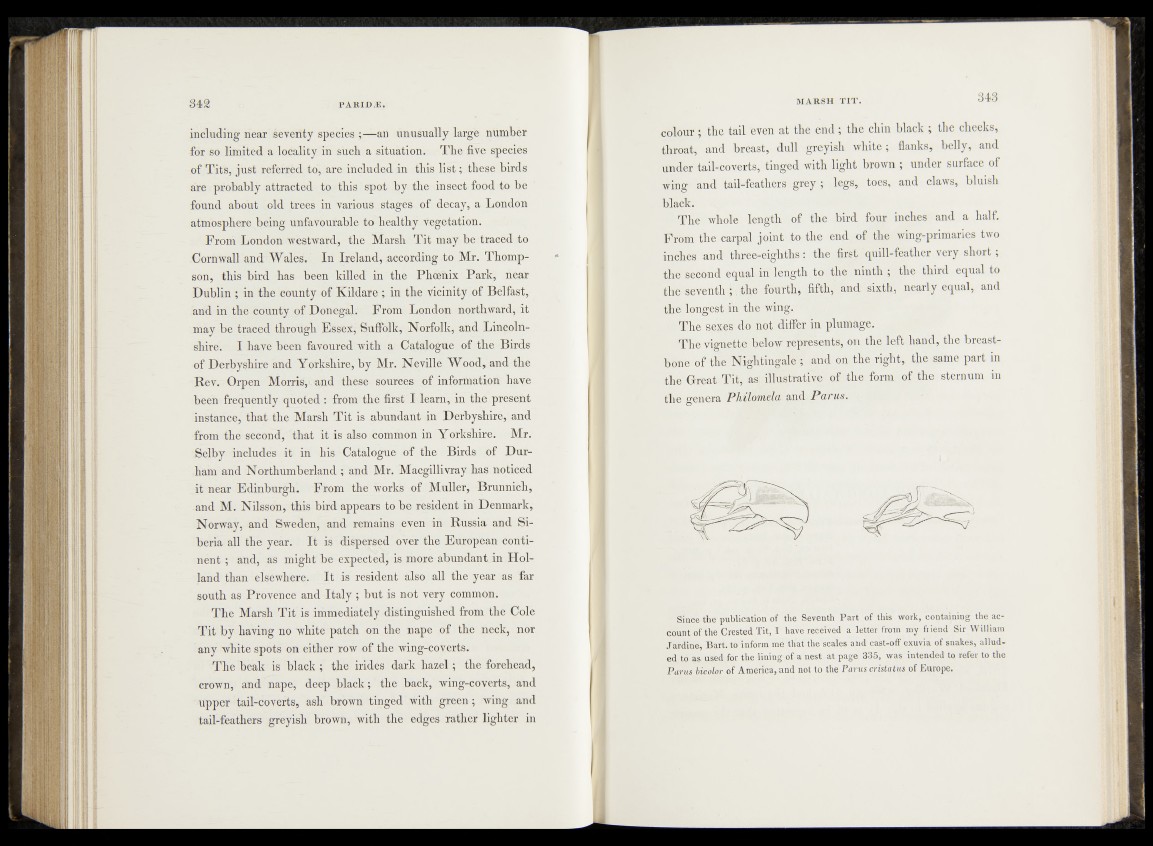
including near seventy species ;—an unusually large number
for so limited a locality in such a situation. The five species
of Tits, just referred to, are included in this list; these birds
are probably attracted to this spot by the insect food to be
found about old trees in various stages of decay, a London
atmosphere being unfavourable to healthy vegetation.
From London westward, the Marsh Tit may be traced to
Cornwall and Wales. In Ireland, according to Mr. Thompson,
this bird has been killed in the Phoenix Park, near
Dublin ; in the county of Kildare ; in the vicinity of Belfast,
and in the county of Donegal. From London northward, it
may be traced through Essex, Suffolk, Norfolk, and Lincolnshire.
I have been favoured with a Catalogue of the Birds
of Derbyshire and Yorkshire, by Mr. Neville Wood, and the
Rev. Orpen Morris, and these sources of information have
been frequently quoted : from the first I learn, in the present
instance, that the Marsh Tit is abundant in Derbyshire, and
from the second, that it is also common in Yorkshire. Mr.
Selby includes it in his Catalogue of the Birds of Durham
and Northumberland ; and Mr. Macgillivray has noticed
it near Edinburgh. From the works of Muller, Brunnich,
and M. Nilsson, this bird appears to be resident in Denmark,
Norway, and Sweden, and remains even in Russia and Siberia
all the year. It is dispersed over the European continent
; and, as might be expected, is more abundant in Holland
than elsewhere. I t is resident also all the year as far
south as Provence and Italy ; but is not very common.
The Marsh Tit is immediately distinguished from the Cole
Tit by having no white patch on the nape of the neck, nor
any white spots on either row of the wing-coverts.
The beak is black ; the irides dark hazel; the forehead,
crown, and nape, deep black; the back, wing-coverts, and
upper tail-coverts, ash brown tinged with green ; wing and
tail-feathers greyish brown, with the edges rather lighter in
colour; the tail even at the end; the chin black ; the cheeks,
throat, and breast, dull greyish white; flanks, belly, and
under tail-coverts, tinged with light brown ; under surface of
wing and tail-feathers grey; legs, toes, and claws, bluish
black.
The whole length of the bird four inches and a half.
From the carpal joint to the end of the wing-primaries two
inches and three-eighths: the first quill-feather very short ,
the second equal in length to the ninth ; the third equal to
the seventh ; the fourth, fifth, and sixth, nearly equal, and
the longest in the wing.
The sexes do not differ in plumage.
The vignette below represents, on the left hand, the breastbone
of the Nightingale ; and on the right, the same part in
the Great Tit, as( illustrative of the form of the sternum in
the genera Philomela and Parus.
Since the publication of the Seventh Part of this work, containing the account
of the Crested Tit, I have received a letter from my friend Sir William
Jardine, Bart, to inform me that the scales and cast-off exuvia of snakes, alluded
to as used for the lining of a nest at page 335, was intended to refer to the
Parus bicolor of America, and not to the Parus cristatus of Europe.